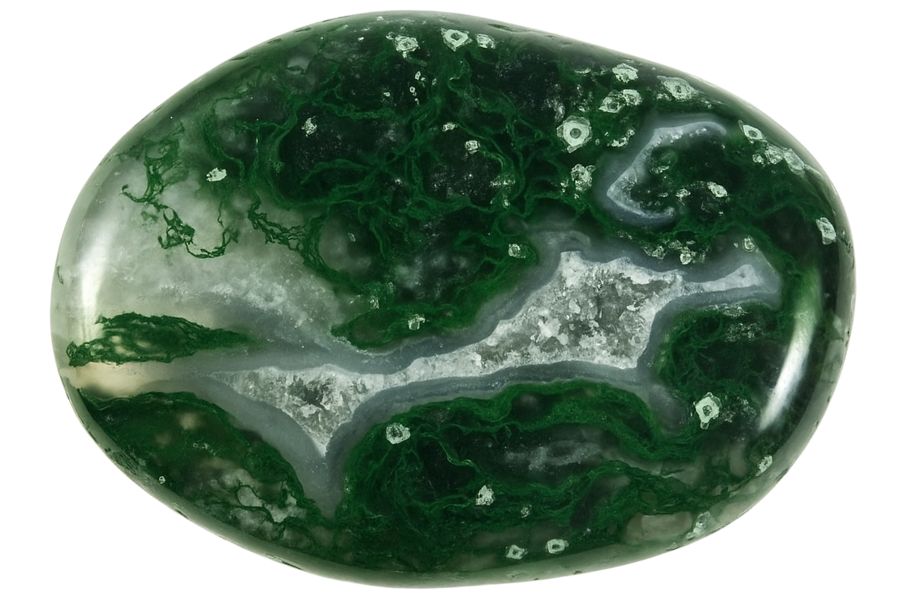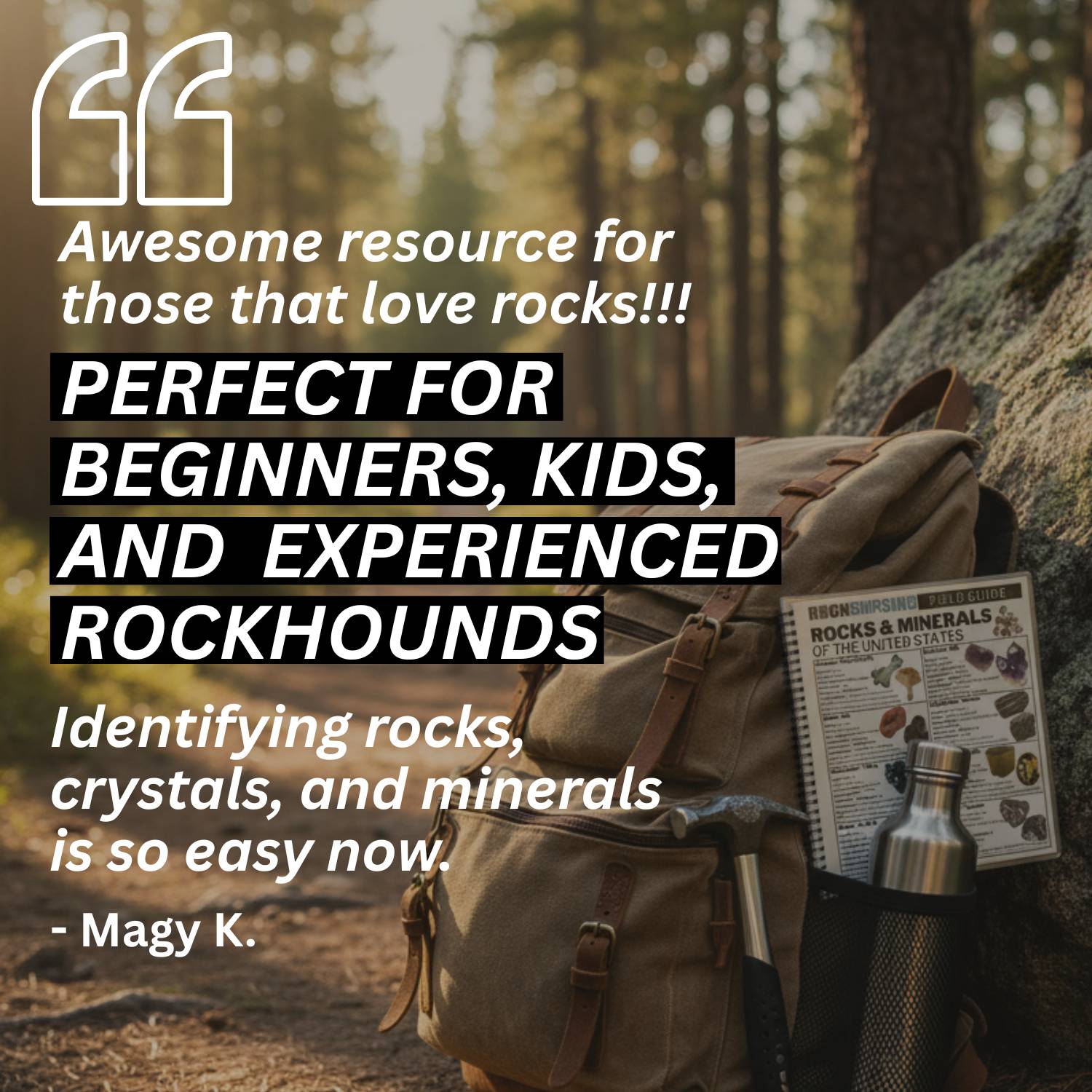People who spend time looking for agates in Idaho quickly learn that patience pays off. The state’s ancient volcanic fields and river systems are full of places where these stones still wash to the surface after a storm.
Some hunters dig through soft rock and gravel, while others prefer to walk riverbanks after the water drops and new stones appear. Every method has its surprises, whether it’s a translucent moss agate or a sharply banded piece of fortification.
Knowing which parts of Idaho’s terrain have seen the most volcanic activity helps narrow your search. It turns the simple act of picking up a stone into a kind of conversation with the earth.
With the right knowledge and a careful eye, you can gather a collection that feels genuinely earned.
What is Idaho Agate?
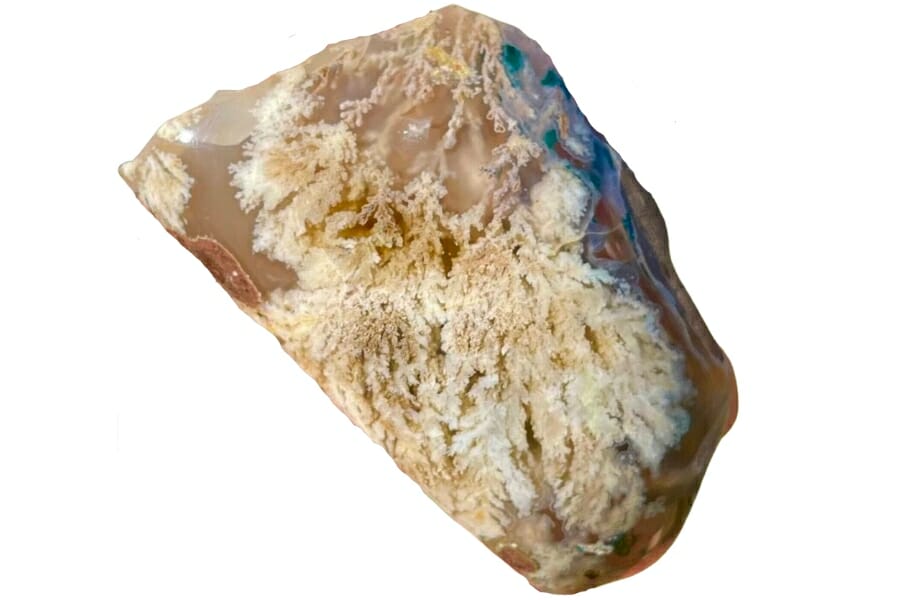
Imagine a stone that isn’t just one plain color but has layers of amazing patterns and colors: that’s an agate! With its naturally captivating looks, it’s no wonder agate’s value and price can go through the roof sometimes.
Agates are formed inside volcanic rocks when pockets of gas get filled with minerals over a long, long time. As the minerals build up, they create those awesome patterns.
Lucky for you, Idaho is one of the awesome places where you can find agates! In fact, our state has many spots where these beautiful stones wait to be uncovered.
But before we proceed to that discussion, let’s first go through the different types of agates and whether you can find them in Idaho:
Blue Lace Agate
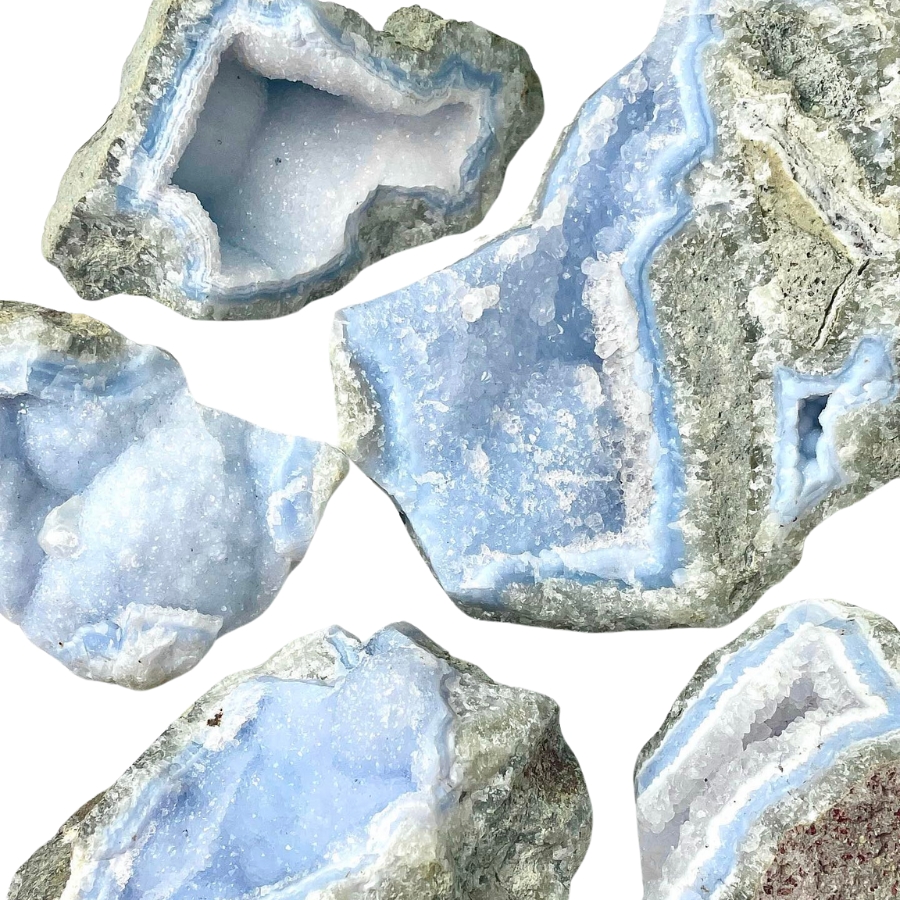
Blue lace agate is like the soft, sky-blue waves with lines that swirl and twist like delicate lace.
Its pattern comes from slow-forming layers of quartz, which create those beautiful, lace-like bands.
The bands of this agate type are often in shades of light blue, white, and sometimes a bit of grey. It’s different from other agates, which usually have more intense colors and stronger patterns.
The value of blue lace agate lies in its soft, tranquil look and the feeling of calm it brings. It’s often used in jewelry or as a decorative stone.
If you want REAL results finding incredible rocks and minerals you need one of these 👇👇👇
Finding the coolest rocks in isn’t luck, it's knowing what to look for. Thousands of your fellow rock hunters are already carrying Rock Chasing field guides. Maybe it's time you joined the community.
Lightweight, mud-proof, and packed with clear photos, it’s become the go-to tool for anyone interested discovering what’s hidden under our red dirt and what they've already found.
Join them, and make your next rockhounding trip actually pay off.
What makes it different:
- 📍 Find and identify 140 incredible crystals, rocks, gemstones, minerals, and geodes across the USA
- 🚙 Field-tested across America's rivers, ranchlands, mountains, and roadcuts
- 📘 Heavy duty laminated pages resist dust, sweat, and water
- 🧠 Zero fluff — just clear visuals and straight-to-the-point info
- ⭐ Rated 4.8★ by real collectors who actually use it in the field
Moss Agate
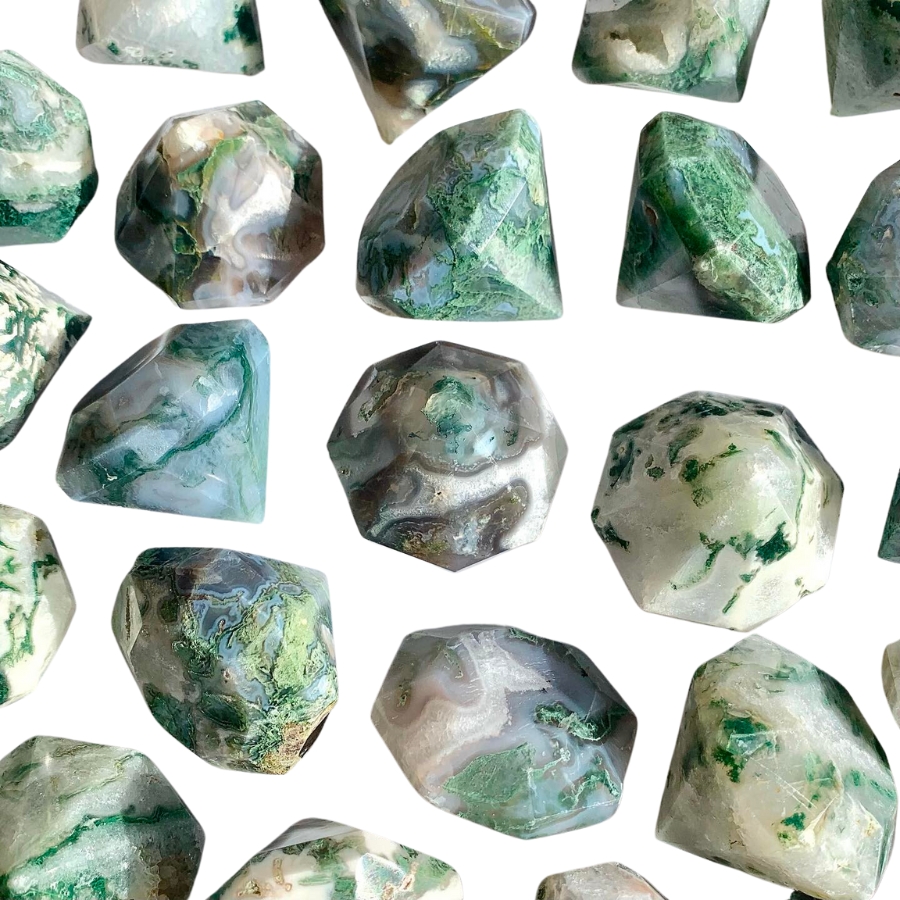
Instead of having the typical banding for which the different types of agates are known, moss agate has green inclusions that look like moss or trees.
These green patterns aren’t real plant material, though. They’re minerals like chlorite or iron oxide.
In some cultures, this type of agate is known as the “gardener’s stone” because of its green, plant-like appearance. It’s believed to help plants grow.
The price of moss agate can vary. It’s often quite affordable, but the more distinct and picturesque the green patterns, the more it might cost.
Fire Agate
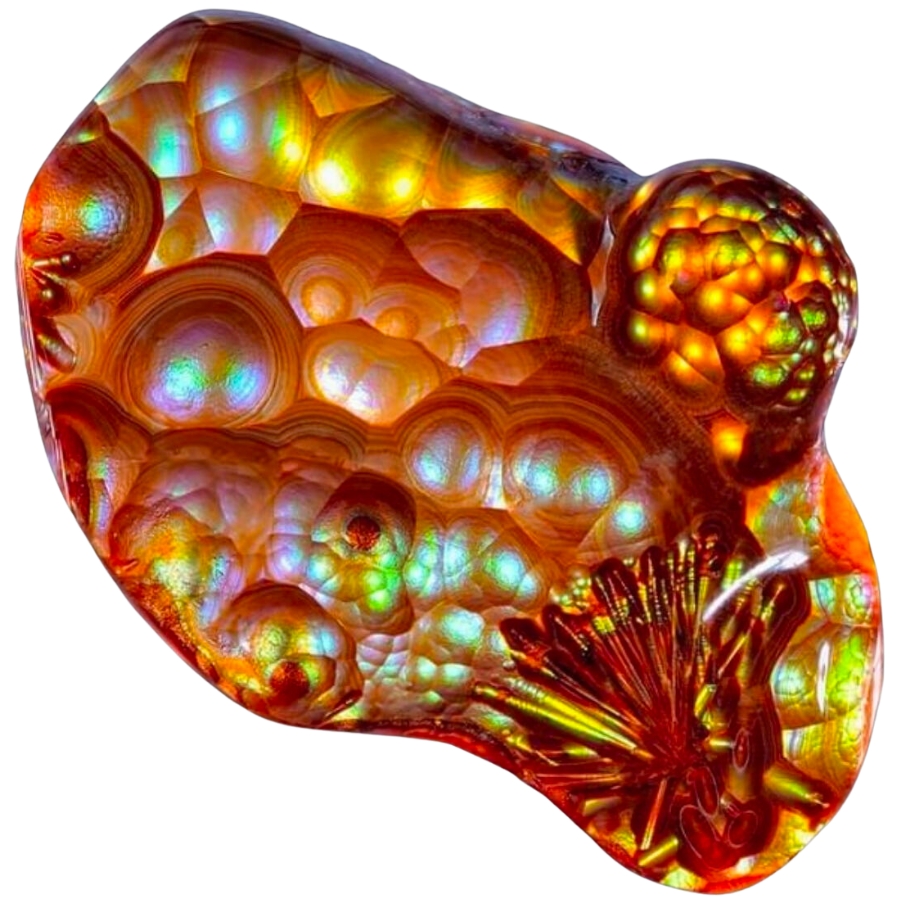
Fire agate is known for its incredible colors and the way it sparkles like fire. It’s got layers of silica and iron oxide that reflect light, creating a fiery effect.
When you look at fire agate, it’s like seeing flames trapped inside. Its colors can range from reds and oranges to greens and golds, all shimmering under the surface.
You might be wondering, “What is fire agate worth?” Well, its value comes from its rare beauty. The more color and sparkle, the more valuable the stone is.
Its fiery iridescence and lively play of color are used in jewelry pieces that are meant to stand out.
Dendritic Agate
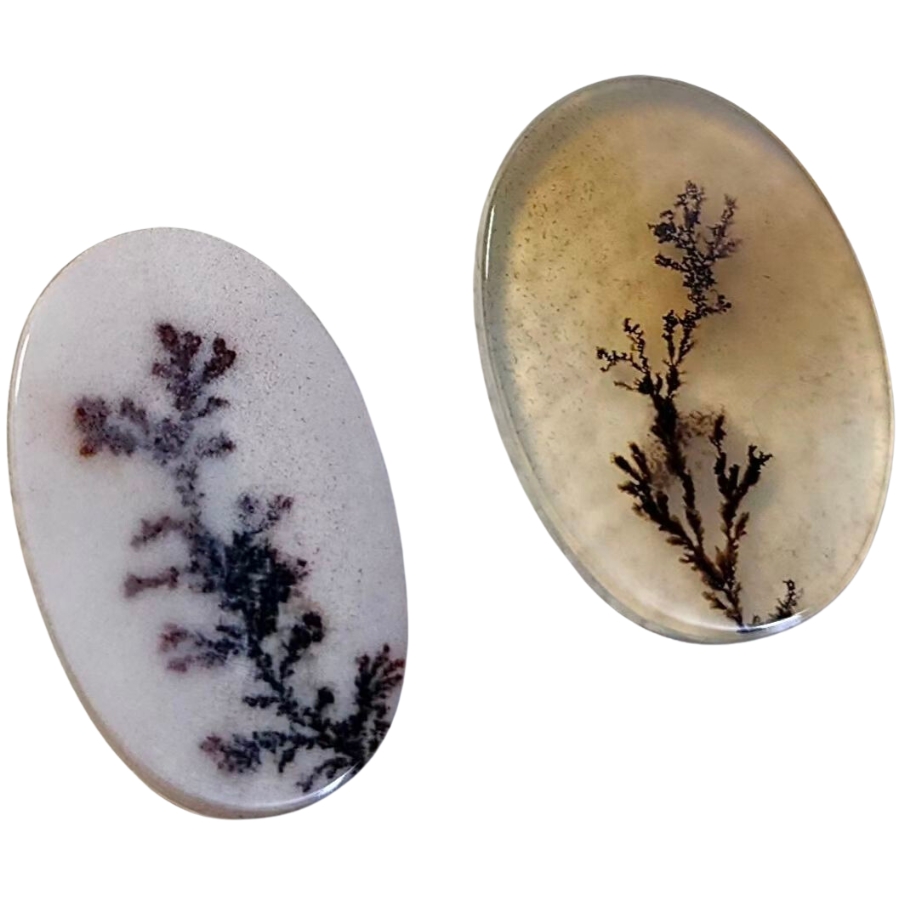
Dendritic agate is known for patterns that look like tiny trees or shrubs. Like moss agate, these patterns aren’t actual plants. They’re made of minerals, mostly manganese or iron oxides.
When you look at a dendritic agate, it’s like peering into a miniature forest or a frosty winter landscape.
The base of the stone is usually translucent to opaque, and the “dendrites”— those tree-like patterns— are often black or brown.
When it comes to how much dendritic agate is worth, it can vary. The more detailed and distinct the patterns are, the more it’s usually valued.
In some cultures, dendritic agate is believed to bring fullness and richness to life.
Crazy Lace Agate
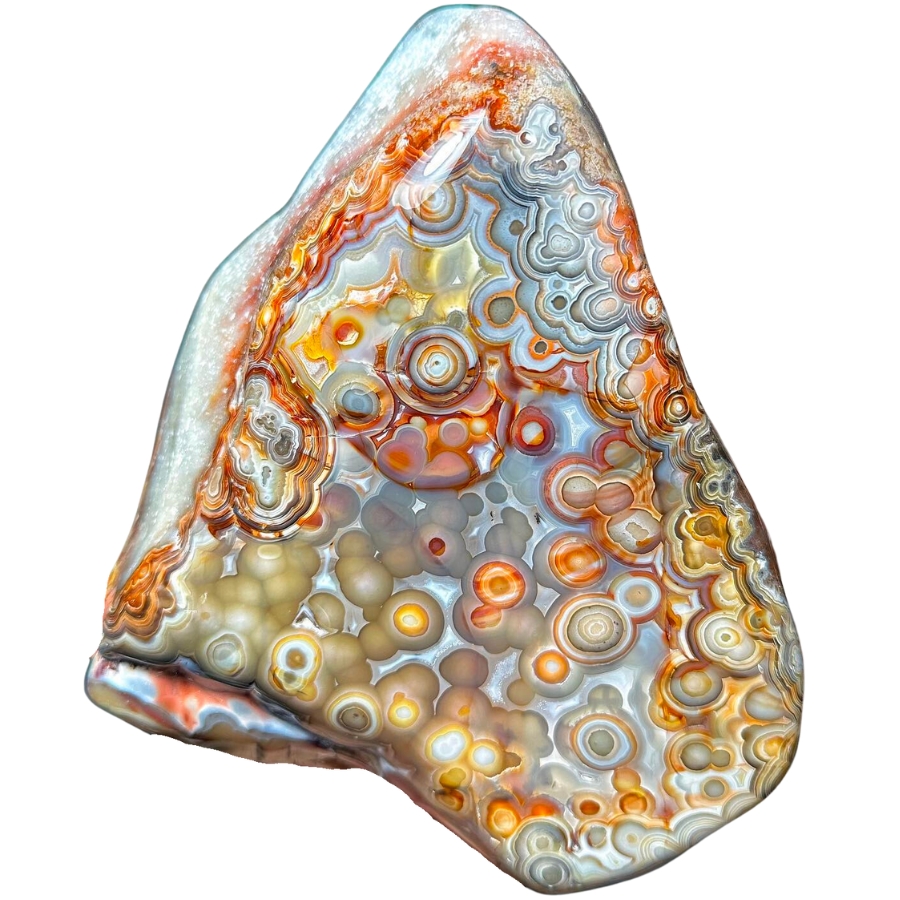
Crazy lace agate is like a party in a rock! It’s got swirls, circles, and all sorts of wild patterns dancing across it.
Its colors can be a mix of red, orange, yellow, and brown, and sometimes even a bit of gray or white.
What makes crazy lace agate stand out is its vibrant and complex patterns. No two pieces are the same. This distinctiveness is a big reason why it’s so valued.
Despite its wild and ‘crazy’ appearance, it’s sometimes called the “Laughter Stone” or “Happy Lace” because of the joy and positive vibes it’s believed to bring.
Laguna Agate
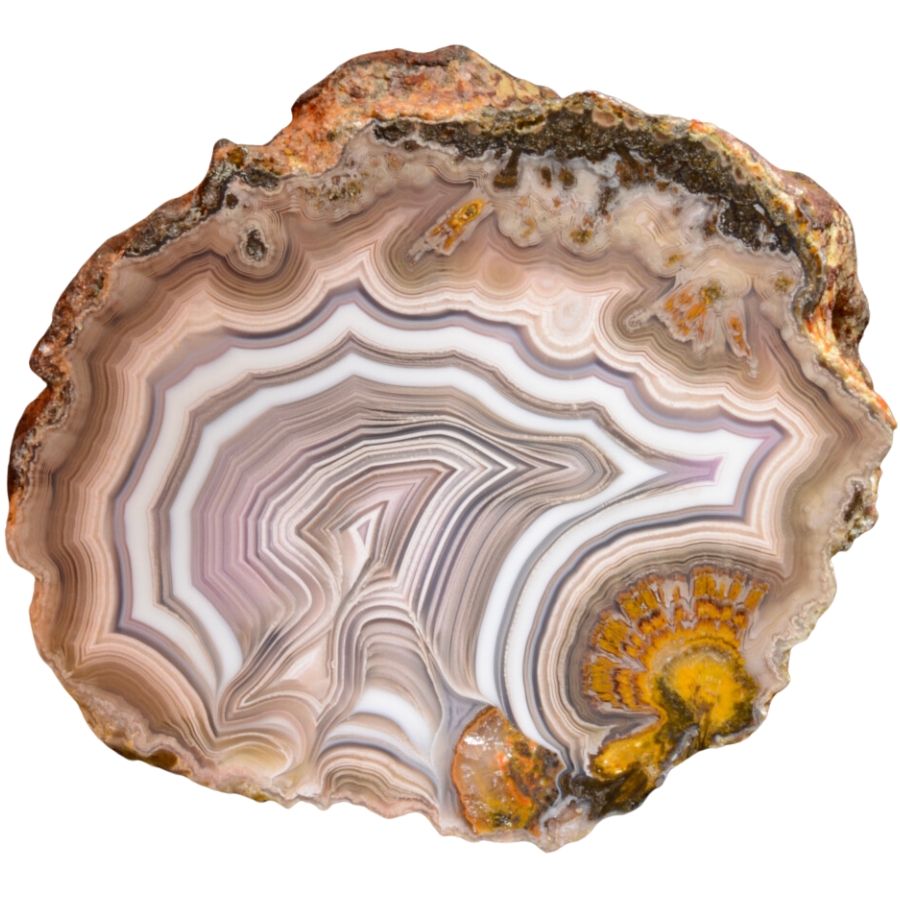
Laguna agate has incredibly sharp and fine banding. It has layers of red, orange, pink, yellow, and sometimes even purple and white all stacked in neat, tight bands.
These bands can form eye-catching patterns, like swirls, loops, and even landscapes.
The different colors of its bands come from various minerals present in the water at the time of its formation.
Laguna agate is considered one of the finest agates in the world due to its exceptional banding. This high regard among agate varieties makes it a prized possession for collectors.
Condor Agate
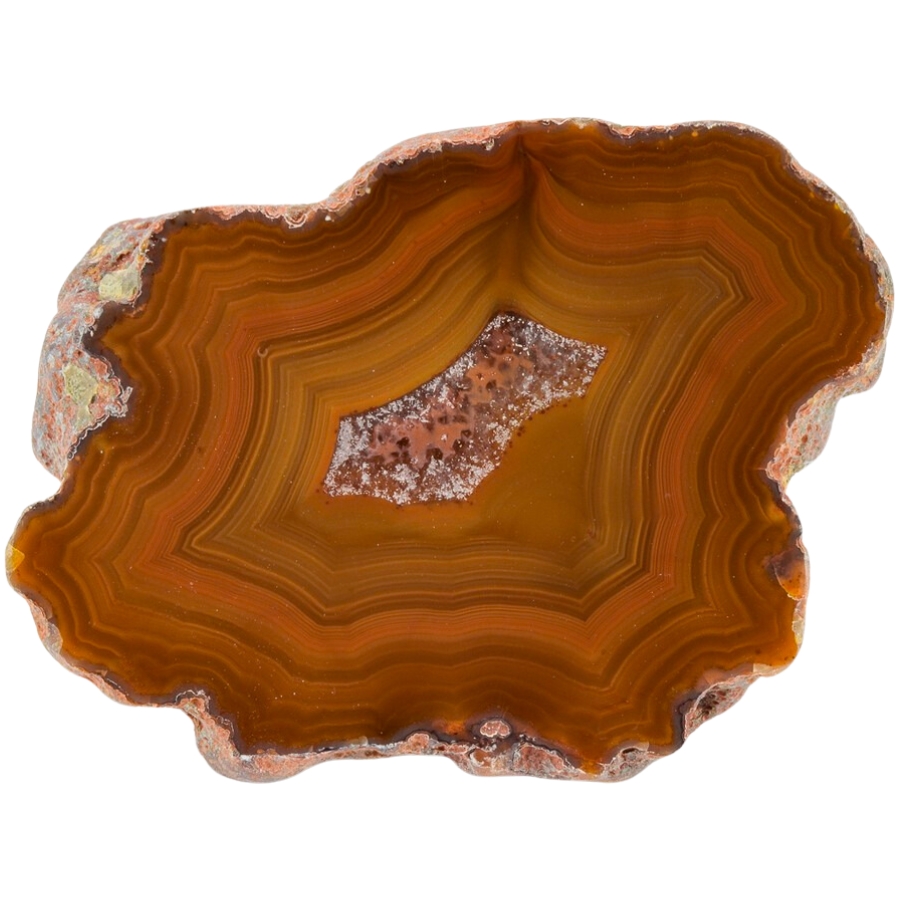
Condor agate is a real standout. It’s known for its bright, vivid colors and complex patterns.
It has reds, oranges, yellows, and sometimes even blues and greens all swirling together. These colors form in bands or in more random, artistic patterns.
The intensity and variety of its colors is what makes condor agate so special. It’s often used by artists and craftsmen who want to make a statement with their work.
Condor agate’s bold colors and patterns can turn a simple piece of jewelry or art into something really eye-catching.
Fortification Agate (Banded Agate)
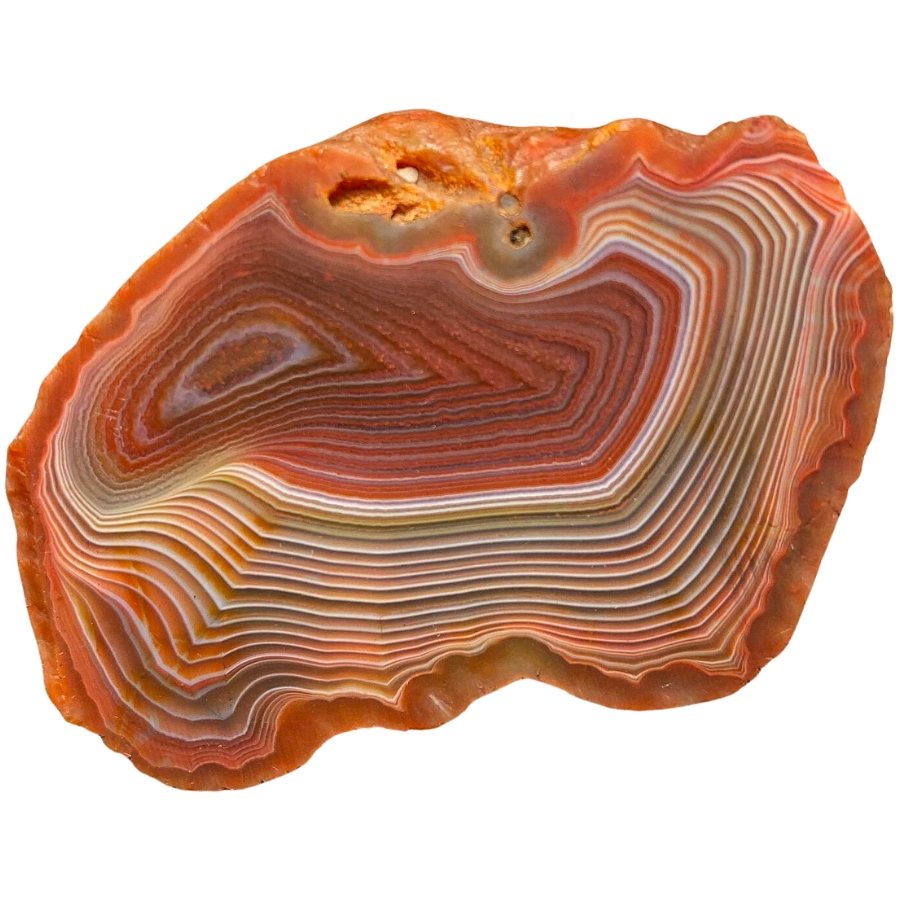
Fortification agate gets its name because the patterns inside it look like the aerial view of a fortified city.
Imagine seeing bands of color forming shapes that look like walls, with sharp angles and curves. They are usually in different colors, making each layer stand out.
If fortification agate is valuable, it’s because of its distinct patterns and colors. Its unique look makes it sought after for jewelry and as a collector’s item.
The clearer and more defined the patterns, the more valuable the stone can be. Some people also believe it can help with relaxation and calmness.
Iris Agate
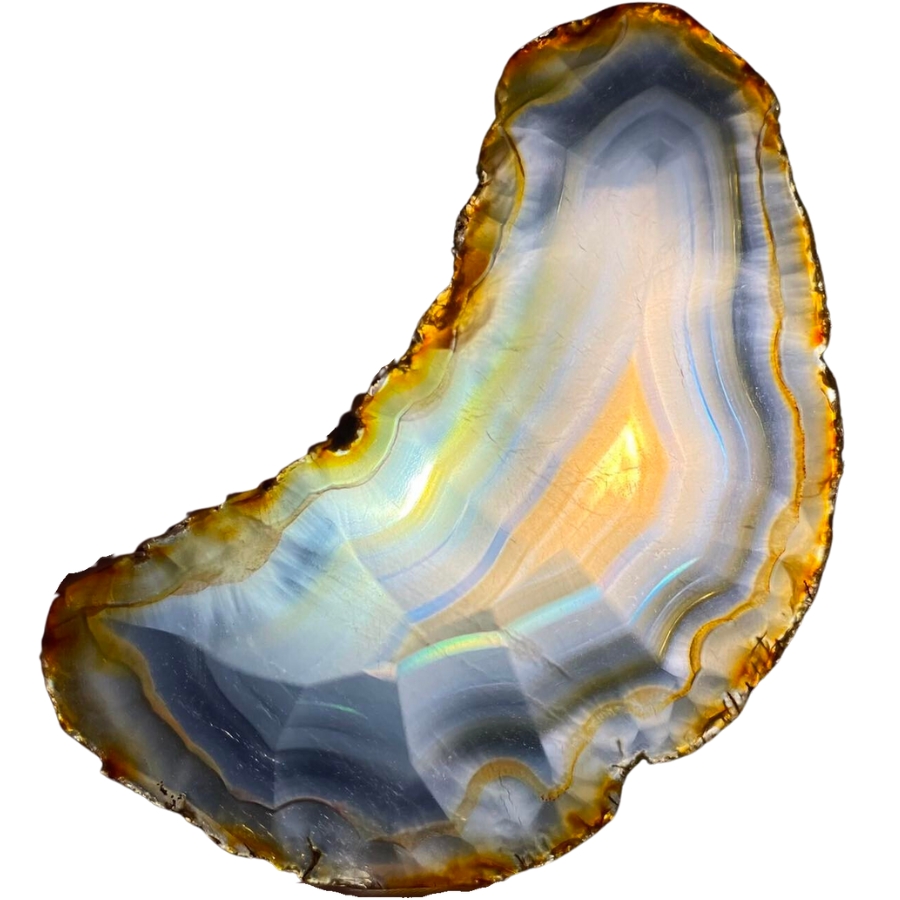
Iris agate looks like a regular agate at first, but when you hold it up to the light, something amazing happens. It shows all these rainbow colors, like light passing through a prism.
This is because it has very thin layers of silica, and when light hits these layers, it splits into all the colors of the rainbow.
The formation of iris agate is similar to other agates, but its layers are super thin, which is what creates the rainbow effect.
The value of iris agate comes from its unique ability to show these colors. In the past, people even used to think it had magical properties because of the way it showed colors. They saw it as a stone of good luck and wonder.
Plume Agate
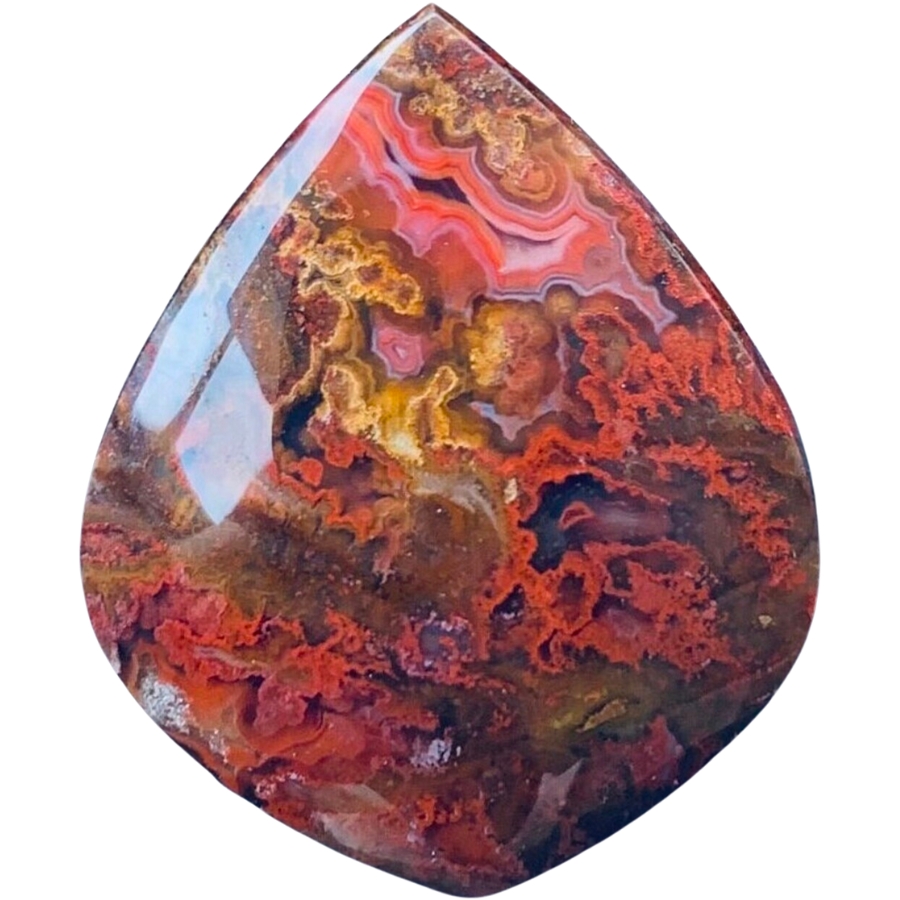
Plume agate gets its name from its patterns that look like soft, feathery plumes. These plumes can be in all sorts of colors: red, black, green, or yellow, set against a translucent or opaque background.
The way these plumes seem to float in the stone makes it look like a frozen underwater scene or like feathers caught in a breeze.
The plumes are made of minerals like manganese or iron oxide, which get trapped in the silica during the agate’s formation and create the feathery patterns.
The price of plume agate can vary depending on how clear and intricate the patterns are. The more detailed and colorful the plumes, the more the stone is usually worth.
Picture Agate (Scenic Agate)
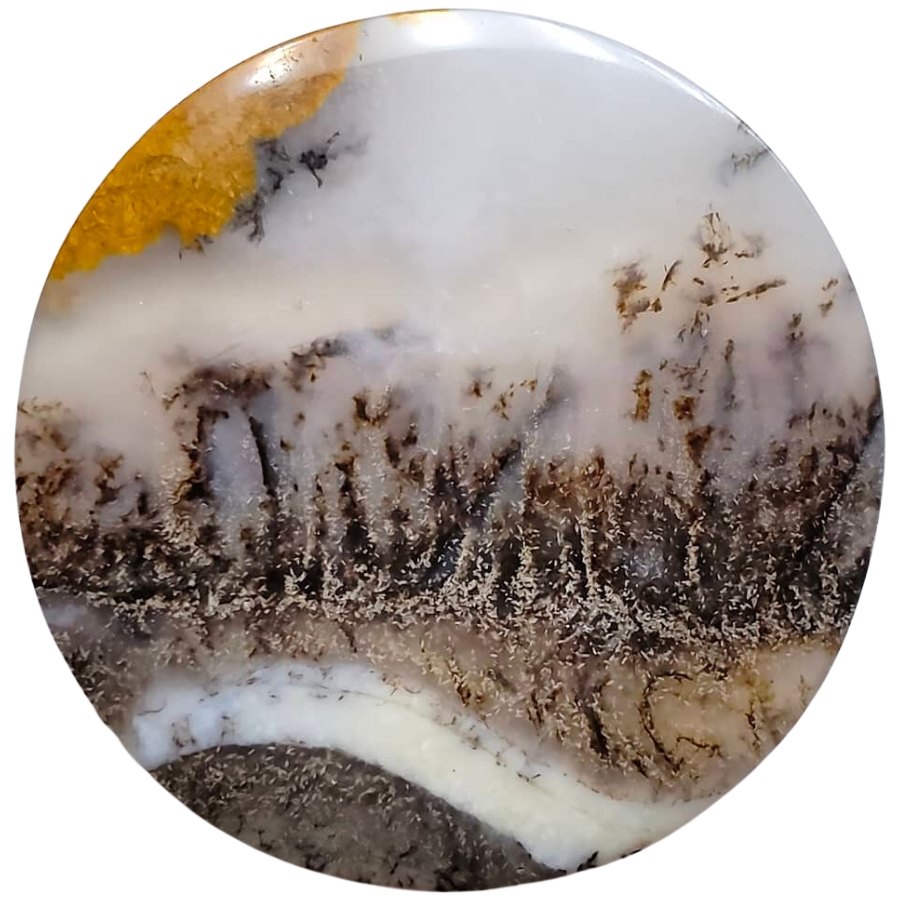
Picture agate is like a snapshot of nature captured in stone because it looks like it has pictures or scenes right inside it.
These “pictures” are actually natural patterns that resemble landscapes, mountains, trees, or even skies. They are usually in different shades of brown, white, and gray against a more translucent background.
The different patterns in picture agate or what’s also called scenic agate are made by various minerals in the water filled with silica that forms it.
If you’re thinking, “What is picture agate worth?“, its value comes from how distinct, clear, and detailed the natural “pictures” are.
Turritella Agate
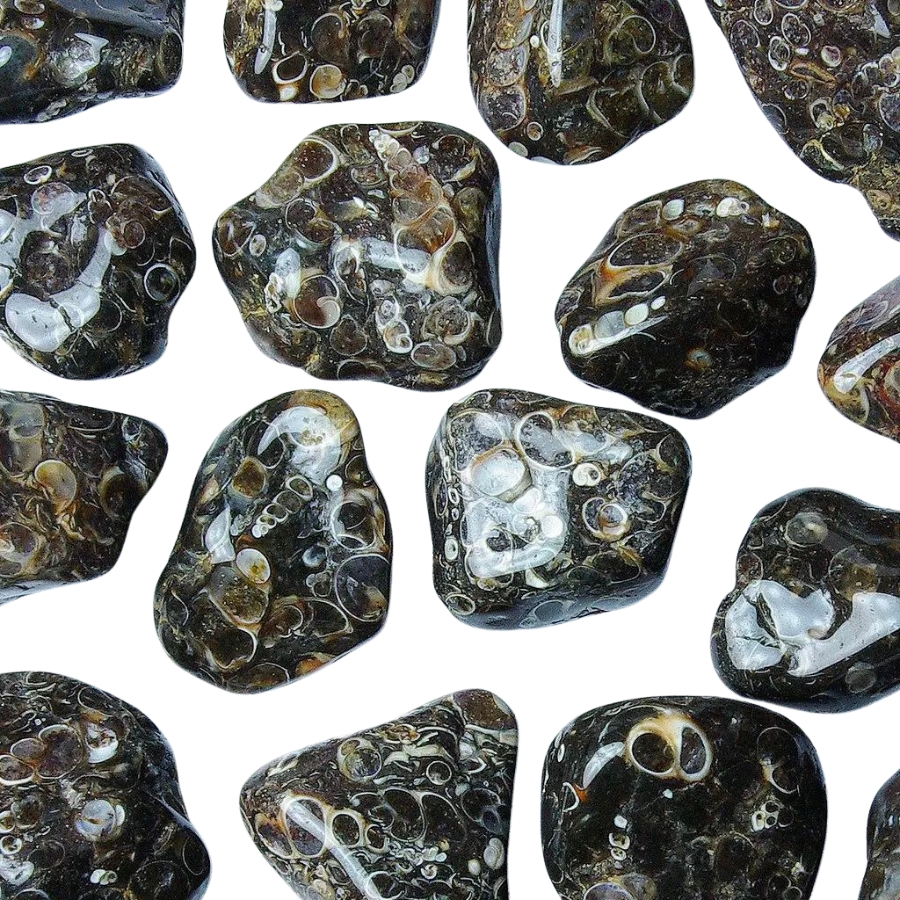
Turritella agate is not your typical agate because it’s full of fossilized snail shells! The shells belong to a creature called Turritella, a type of sea snail.
These shells are tightly packed and create a pattern that looks like a bunch of tiny, swirling towers. The background of the agate is usually a dark, earthy color, which makes the white or cream-colored snail shells really pop.
Over millions of years, these snail shells got buried in sediment and eventually became fossilized. As time went on, silica-rich water flowed through the sediment, turning it into the agate we see today.
The value of turritella agate comes from its unique blend of geology and history. More than a pretty stone, it’s a piece of ancient life preserved in rock.
Fairburn Agate
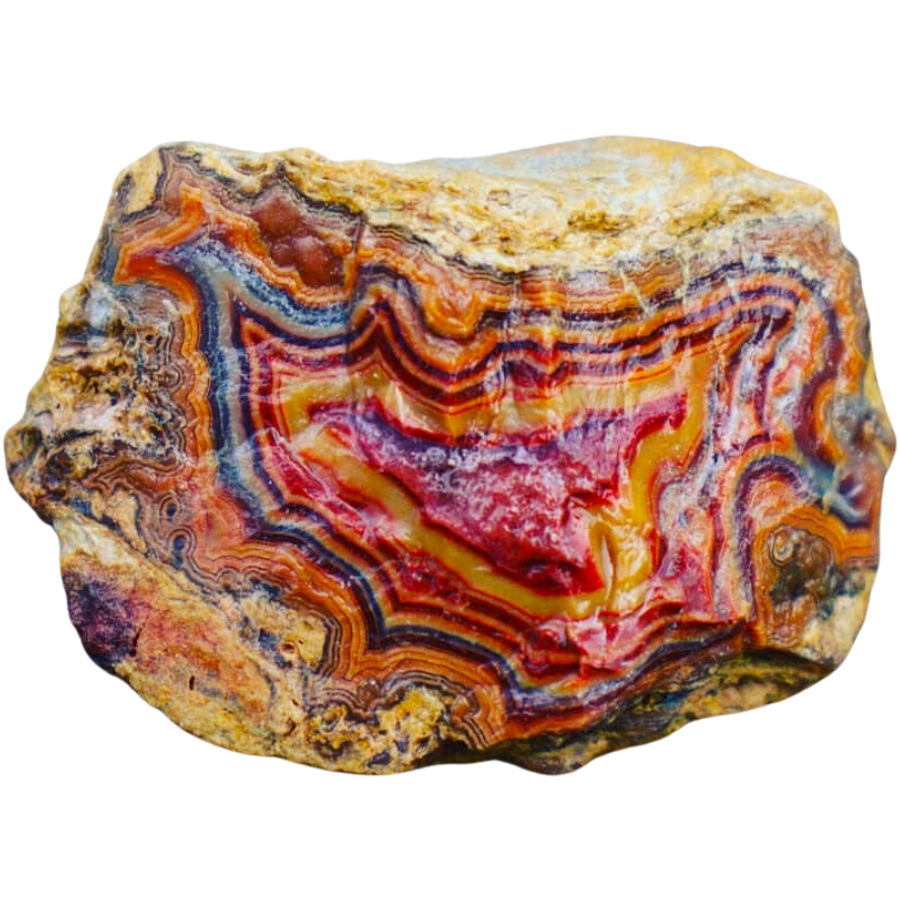
Known for its intricate patterns and bold colors, Fairburn agate is another fascinating type of agate. It usually has bands and swirls of different colors like red, yellow, orange, brown, and sometimes even pink or purple.
What’s special about these patterns is they often look like they’re in layers, creating a 3D effect. It’s like looking at a landscape made of stone.
It’s named after a place called Fairburn in South Dakota. This gives a clue about where it was first discovered.
People value Fairburn agate for the skill it takes to cut and polish it, which makes the patterns and colors really stand out.
Sagenite Agate
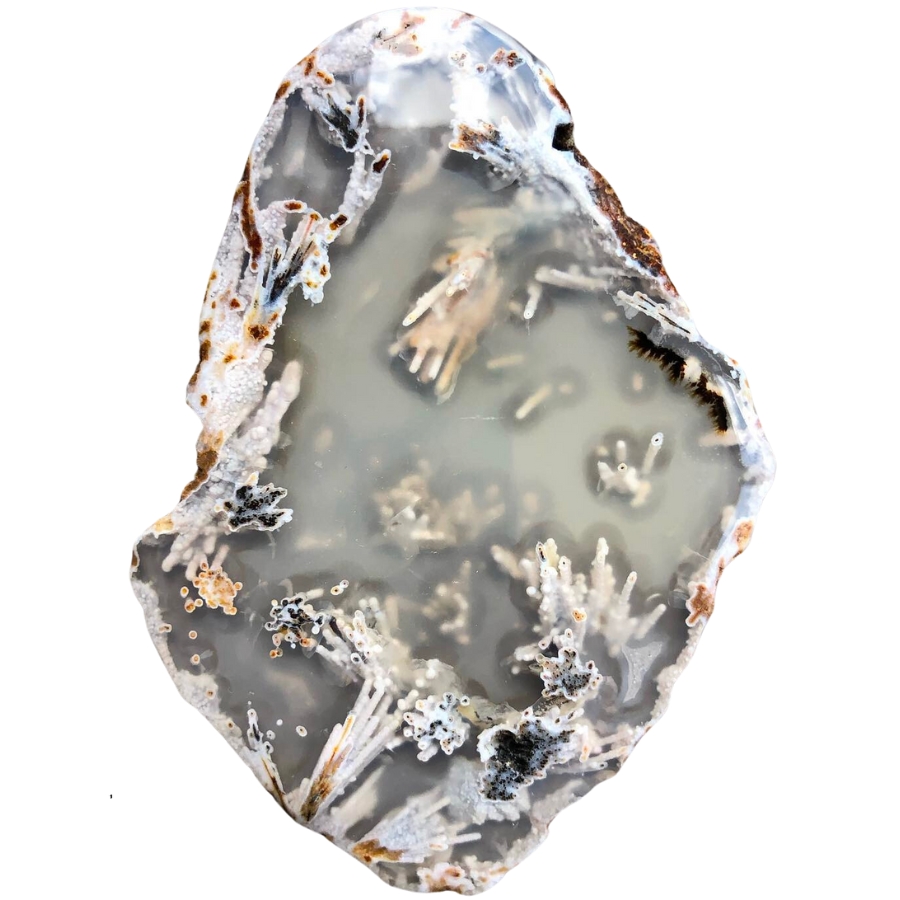
Sagenite agate has needle-like inclusions that look like tiny sprays of crystals inside it. They can be gold, silver, black, or even green, and they spread out in all directions, creating an amazing pattern.
The base of the agate is usually translucent, which lets you see these intricate needle patterns clearly.
These patterns are actually other minerals, like rutile or goethite, that get trapped inside the forming agate. These minerals grow in a crystal shape, looking like needles or hair.
Sagenite agate is often used in jewelry and other decorative items, with some people thinking that its needle patterns look like fireworks or starbursts.
Tree Agate
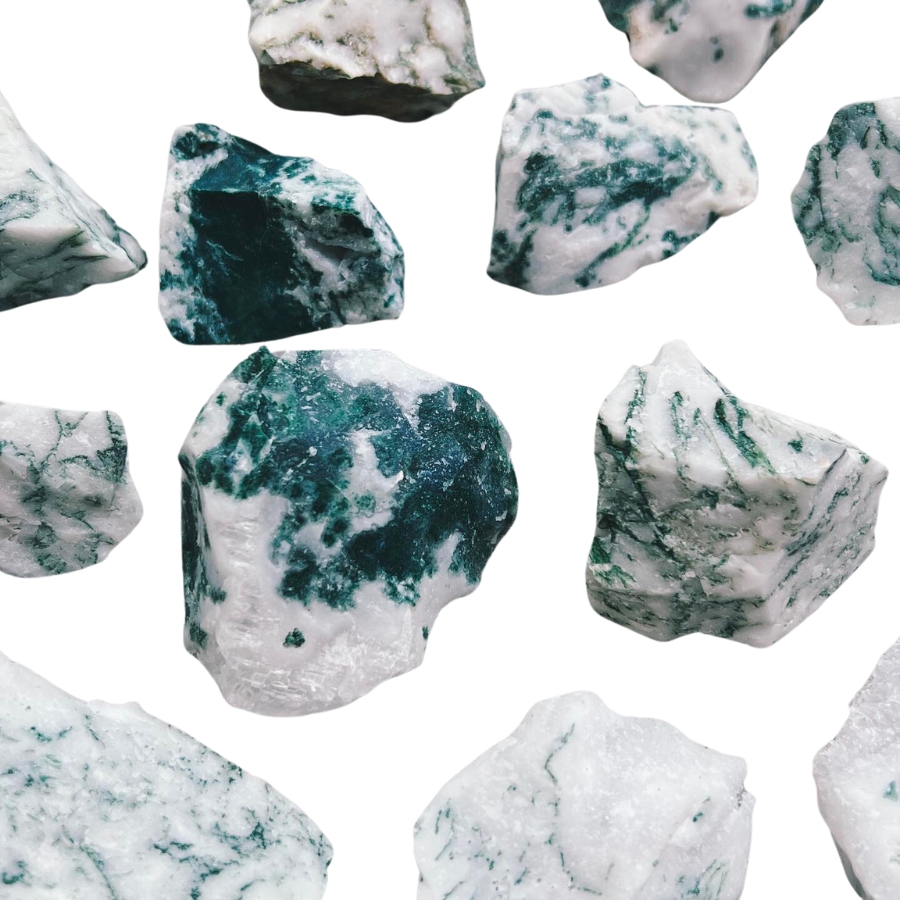
Tree agate, as its name suggests, looks like it’s got tiny trees or branches inside it. These tree-like patterns are usually green and spread out against a white or light gray background.
The green patterns aren’t actual trees, though. They’re made of minerals like chlorite or manganese.
Each piece of tree agate is different. You won’t find two that are exactly the same. It’s valued for its looks and it’s often used in jewelry and decorations.
The key factors in our recommendations are:
- The deep experience and understanding of our team about the area
- Recommendations from local groups and clubs
- How easy it is to get the a particular location
- Safety and potential hazards when collecting
- Weighing private and public locations
- The ability for both experienced and novice agate enthusiasts to find great samples
With these factors in mind we’ve been able to put together a fantastic list that just about anyone can use!
Kids. Beginners. Pros. Doesn’t matter. This book has become the go-to because it works for everyone.
Magy put it bluntly: “Identify rocks, crystals and minerals is so easy now!”
That’s not by accident, the photos are crisp, the callouts are simple, and the design is rugged enough to throw in a backpack without worrying. Whether it’s your first geode or your hundredth, this guide keeps the fun part simple: finding more treasures.
The Best Spots To Find Agates in Idaho
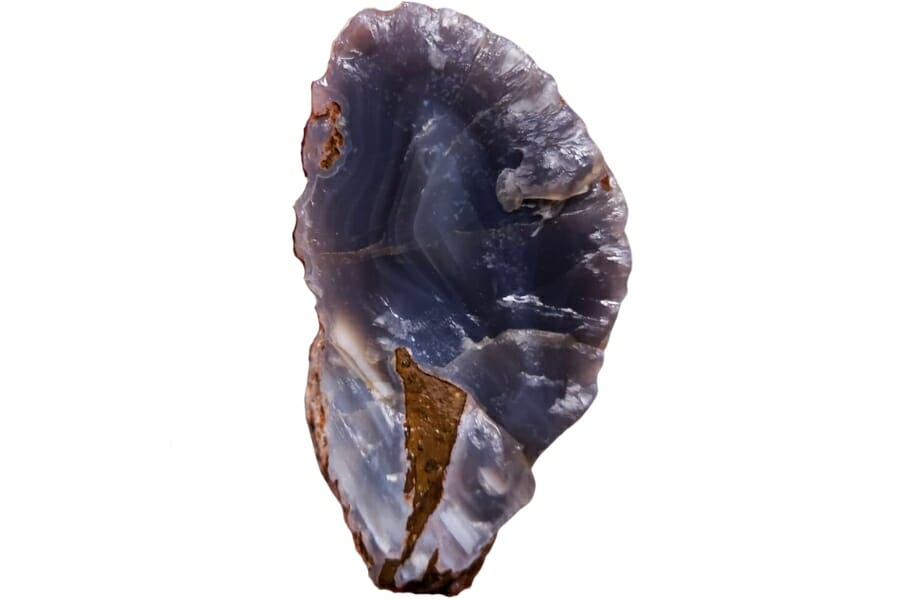
Our state is not one to quickly run short of natural wonders, so it’s no surprise that there are many great gem mine sites in Idaho. But if you want a guide that’s focused on the proven locations where you can find agates, below are your best shots:
Always Confirm Access and Collection Rules!
Before heading out to any of the locations on our list you need to confirm access requirements and collection rules for both public and private locations directly with the location. We haven’t personally verified every location and the access requirements and collection rules often change without notice.
Many of the locations we mention will not allow collecting but are still great places for those who love to find beautiful rocks and minerals in the wild without keeping them. We also can’t guarantee you will find anything in these locations since they are constantly changing.
Always get updated information directly from the source ahead of time to ensure responsible rockhounding. If you want even more current options it’s always a good idea to contact local rock and mineral clubs and groups
Salmon River
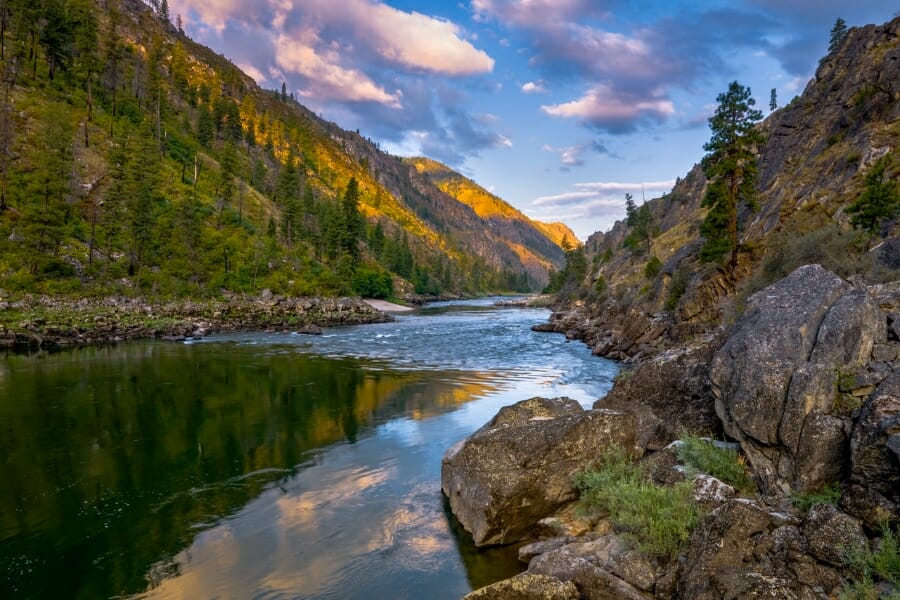
Salmon River, often referred to as the “River of No Return,” stretches over 400 miles, making it one of the longest free-flowing rivers in the lower 48 states. It winds its way from the Sawtooth Valley all the way to the Snake River. Along its journey, it carves through deep canyons, some even deeper than the Grand Canyon!
The geology around the Salmon River isn’t just stunning to look at; it’s also a rockhound’s paradise. Among the treasures you can find here is the beautiful agate.
If you’re thinking of visiting, there are many access points along this river. Highways like the Salmon River Scenic Byway run alongside significant portions of the river. But before you head out, make sure to review Idaho’s latest collecting guidelines.
Where we found agates on Salmon River
You can find agates if you search in the gravels and sands of Salmon River and all its tributaries.
Little Wood River
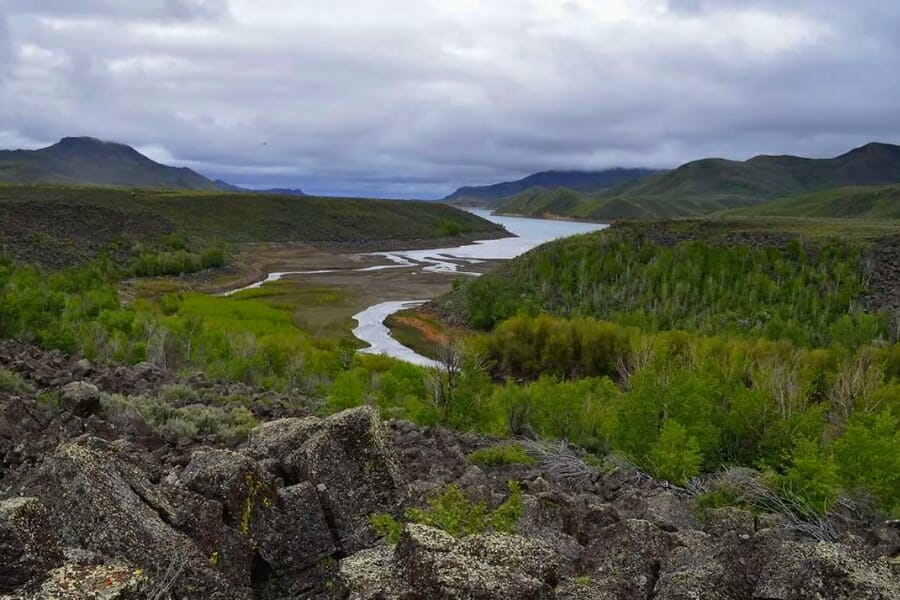
Originating in the Pioneer Mountains, the Little Wood River stretches over a picturesque landscape before finally joining the Snake River. As it flows, it creates a series of beautiful scenes, from meandering streams to more rapid currents.
The land surrounding the Little Wood River is a treat for anyone interested in geology. It boasts of an array of rock formations. The presence of agate here is a testament to the rich mineral history of the area.
If you’re eager to visit, the Little Wood River is relatively accessible. Roads like the US-26 offer scenic routes that provide glimpses of its beauty. There are also multiple points where you can approach the river.
Where we found agates in the Little Wood River
With a keen eye and a bit of patience and luck, you can uncover moss agates in the gravels near Carey and south along the Little Wood River.
Grouse Creek
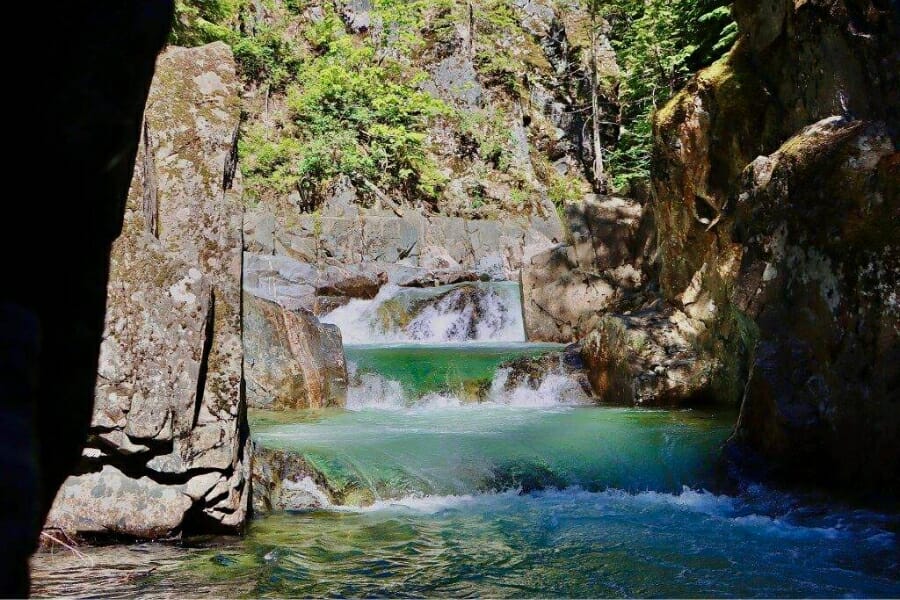
Grouse Creek is a charming waterway that begins its journey in the Albion Mountains and winds through various landscapes before eventually flowing into the Snake River. The journey of this creek offers captivating sights of shimmering waters, tall trees, and rugged terrains.
The geology surrounding Grouse Creek is the result of a mix of geological events over time, from the slow layering of sedimentary rocks to the fiery display of volcanic eruptions. Among the exciting finds here are pretty agates.
If you wish to explore Grouse Creek, the roads leading to it are well-marked, so it will be a straightforward journey for you. There are also several access points where you can approach its waters.
Where we found agates in Grouse Creek
You can find stunning banded agates and iris agates if you explore the area of Grouse Creek which is near Eaton.
Indian Bathtub
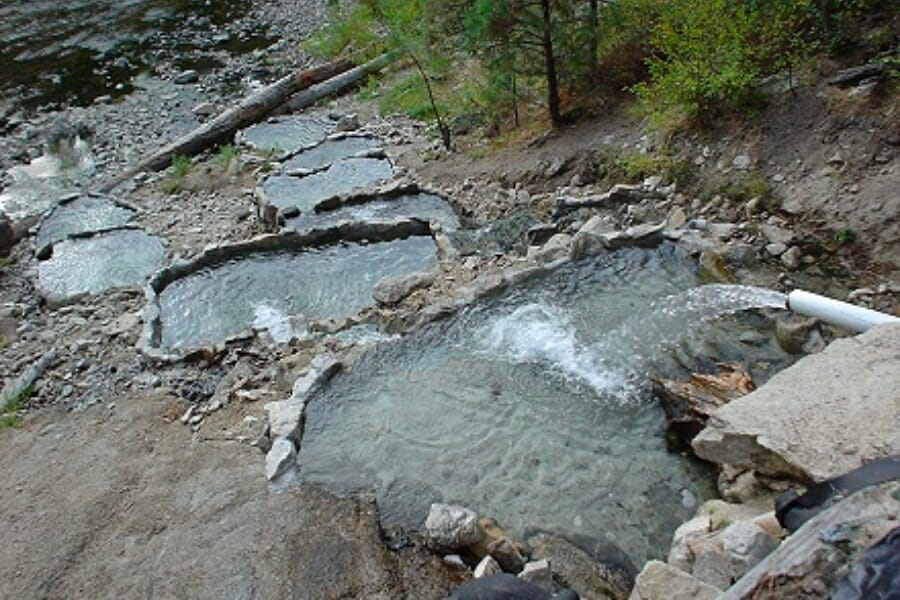
Indian Bathtub is not your typical bathtub. This natural formation is a kind of pool or basin created by the relentless force of water over countless years. It’s surrounded by a landscape of rolling hills, dense forests, and rugged rock formations.
The geology here is rich and varied. The bathtub itself is evidence of the power of water to carve out spaces within solid rock. As you explore, you have the chance to come across agates.
Since this place is located off the beaten path, getting here is an adventure. It offers a more secluded experience, so it might require a bit of a trek. The nearby towns can be a good starting point, and locals often share tips and directions for the best routes. Of course, you can also rely on your trusty GPS and maps.
Where we found agates in the Indian Bathtub
You can uncover elusive purple agates if you explore the general area and the different nooks and crannies of the Indian Bathtub.
Malm Gulch
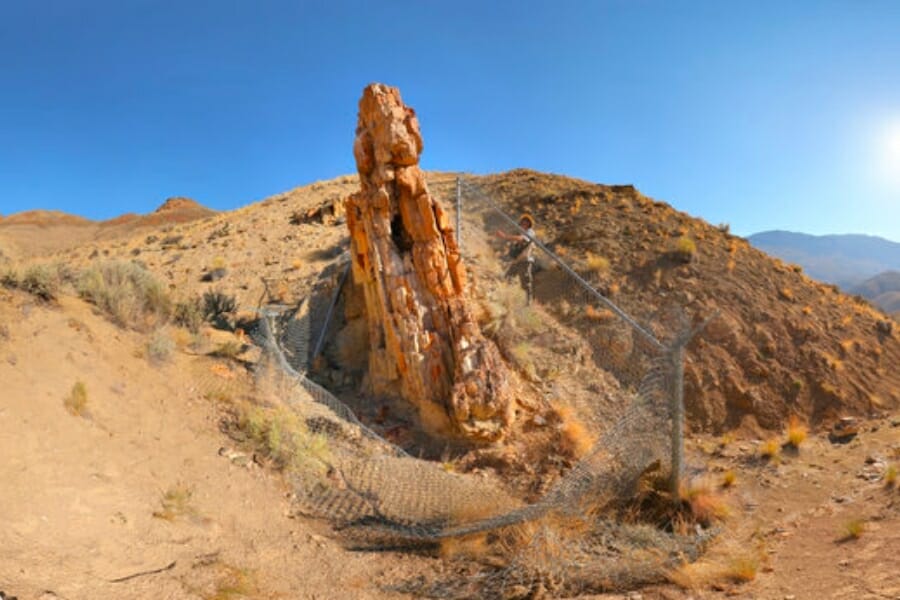
Located in the southern part of our state, Malm Gulch offers a landscape that’s both captivating and full of geological intrigue. It’s a place where rugged terrains meet the gentle touch of nature.
Malm Gulch’s geology is like a page out of Earth’s history book. Over the ages, this area has seen a mix of volcanic activity and erosive forces. These events have left behind an array of rocks and minerals that include fascinating agates.
If you’re thinking of paying a visit to Malm Gulch, you’re in for a journey that’s both scenic and accessible. While some parts of the gulch might require a bit of trekking, there are routes that are more straightforward, making it possible for people of various adventure levels to explore.
Where we found agates in Malm Gulch
You can find agates if you explore and search through the petrified forest ridge in Malm Gulch.
Other Great Places To Find Agates in Idaho
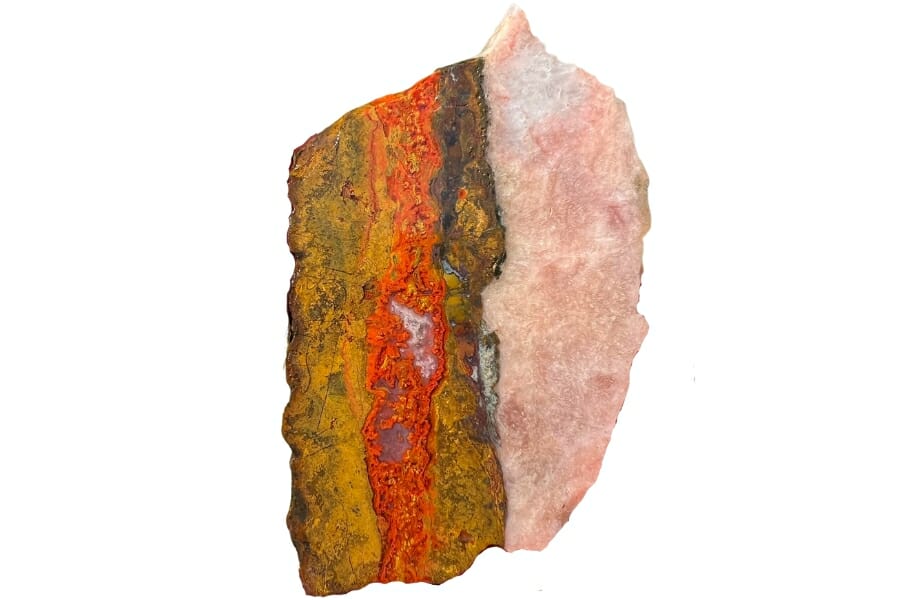
Seam agate photo provided by earthlend61116
Aside from the first five proven locations that we’ve shared, there are plenty of other sites where you can find Idaho agates. We’ve listed them below by county:
Our recommendations by county
| County | Location |
| Ada | Roads, prospects, and almost anywhere |
| Butte | Big Piney Mountain |
| Custer | Lime Creek Road |
| Custer | Meyers Cove |
| Custer | North Fork of Lost River |
| Fremont | Island Park Caldera |
| Gem | Squaw Butte |
| Idaho | South Fork in Kooskia |
| Idaho | Salmon River and all tributaries |
| Idaho | Slate and McKinsey Creeks |
| Lemhi | Parker Mountain |
| Nez Perce | Regional streams in Lewiston |
| Owyhee | Bruneau Desert |
| Owyhee | South near the border in Homedale |
| Owyhee | Graveyard Point |
| Owyhee | Succor Creek |
| Owyhee | Long Gulch mine dumps |
| Valley | Big Creek |
| Washington | Hog Creek |
| Washington | Little Weirser Creek |
| Washington | Weiser Cove |
Additional areas you can find agates
If you’re exploring a generally broad area, you may want to focus on the following specific spots where agates usually hide:
Rivers and Riverbanks
Rivers and riverbanks are like nature’s conveyor belts for gemstones, especially agate. With their flowing waters, rivers carry downstream the agates that were formed from volcanic activities. The movement of water tumbles it, smoothing and rounding its edges.
When these agates reach riverbanks, they get deposited among gravel and sand, waiting to get uncovered. So, wandering along Idaho’s riverbanks increases your chances of spotting these hidden gems.
Streams and Creeks
Streams and creeks are nature’s treasure troves for agate hunters! Here’s why: agates form in volcanic areas, and over the years, the forces of nature wear away the volcanic rocks, setting the agates free. Streams and creeks then act like natural slides for these stones.
Packed with volcanic history and a network of flowing waters, Idaho is a perfect stage for this process. In our streams and creeks, agates settle among the pebbles and stones.
Mountains
Mountains are like giant puzzle boxes hiding many geological treasures. Agates often begin their journey deep within volcanic rocks that form many mountain ranges. These rocks have pockets and holes that turn into agates. As mountains face nature’s forces, they slowly wear down, releasing hidden agates into the open.
Now, think about Idaho with its grand mountains. These mountains have been holding onto agates for millions of years! When you explore these heights, you’re diving into a world filled with potential agate treasures.
Common Agate-Hunting Questions
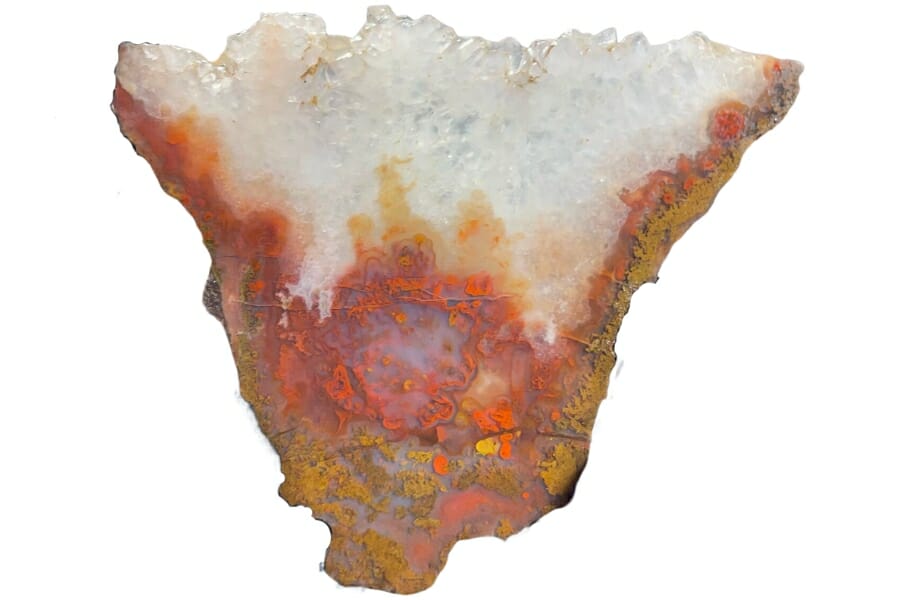
Before you start your exploration, we’ll answer the most common question of those who have tried their hand at finding agates in Idaho:
Is it illegal to collect agate in Idaho?
In Idaho, collecting agates for personal use on public lands, like the Bureau of Land Management (BLM) areas, is generally allowed. However, there are rules and guidelines to follow.
You should avoid designated wilderness areas, archaeological sites, and other sensitive areas. It’s also crucial not to disturb wildlife or their habitats.
Before collecting agates, it’s always a good idea to check specific regulations for the area you plan to visit and obtain any necessary permits or permissions. For more information, visit the Idaho Department of Lands (IDL) website.
The Best Places To Buy Agates In Idaho
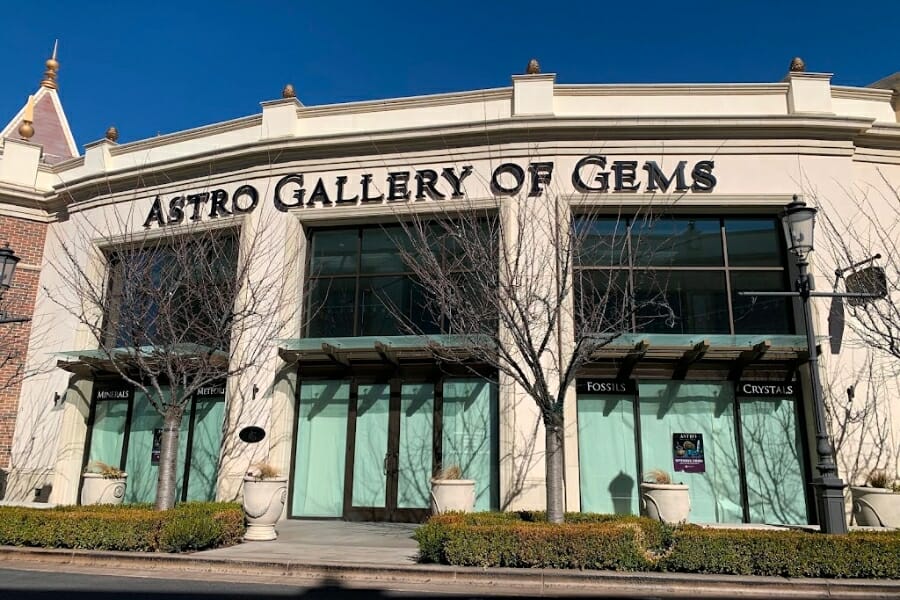
If you want a more stress-free and relaxed way of observing and bringing home an agate, you can visit our trusted local rock and mineral shops that showcase these gems. Below are some of them:
- Astro Gallery of Gems – 3525 E Longwing Ln #190, Meridian, ID 83642
- Earth Brite Rock Shop – 3506 Cleveland Blvd, Caldwell, ID 83605
- Earthlight Minerals & Gifts – 6437 W Fairview Ave, Boise, ID 83704
- Stone Timbers – 6742 S Zephyr Way, Boise, ID 83709
- Yellowstone Gem World – 116 N Bridge St, St Anthony, ID 83445
If you have any recommendations for our list please leave a comment below!

